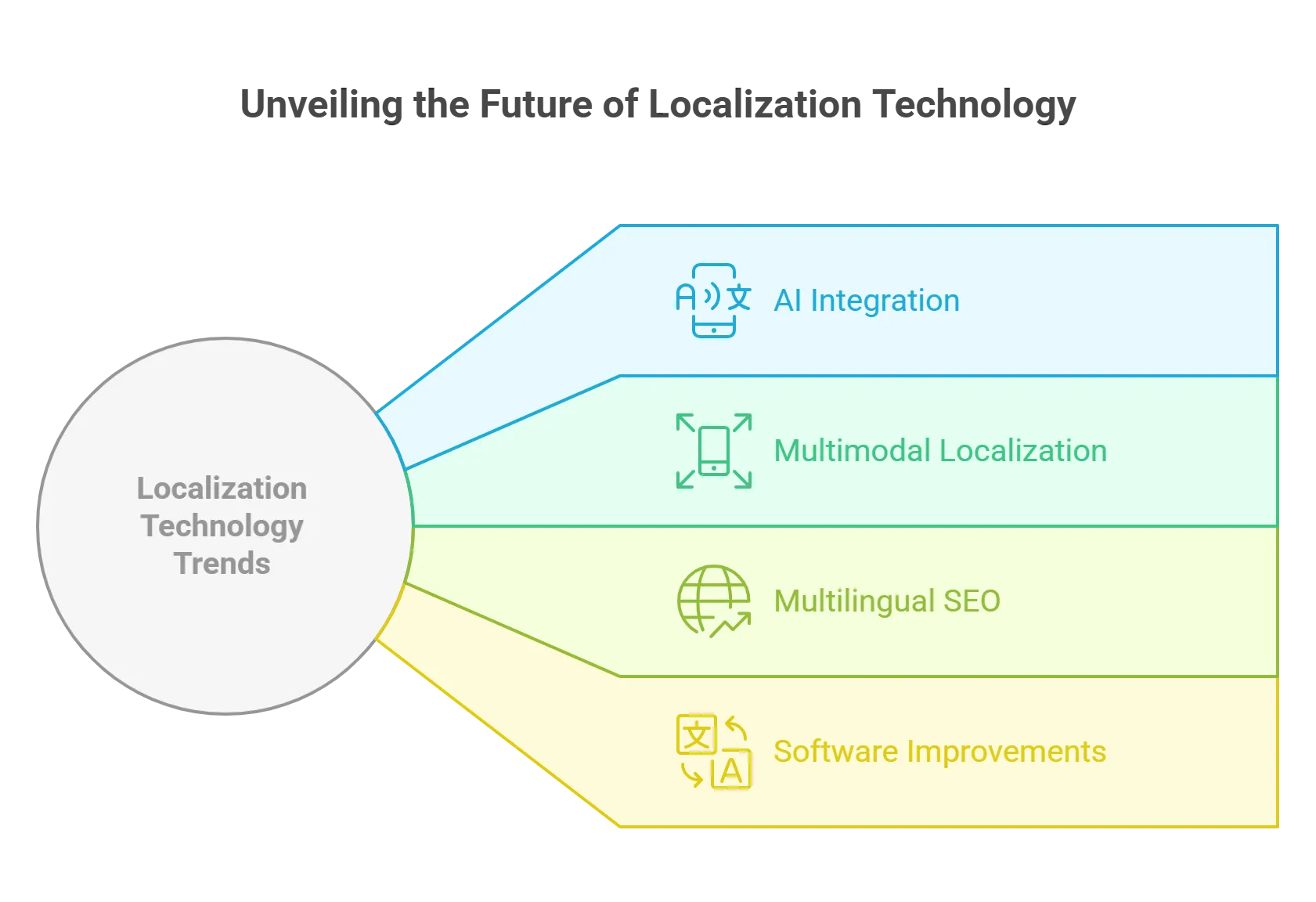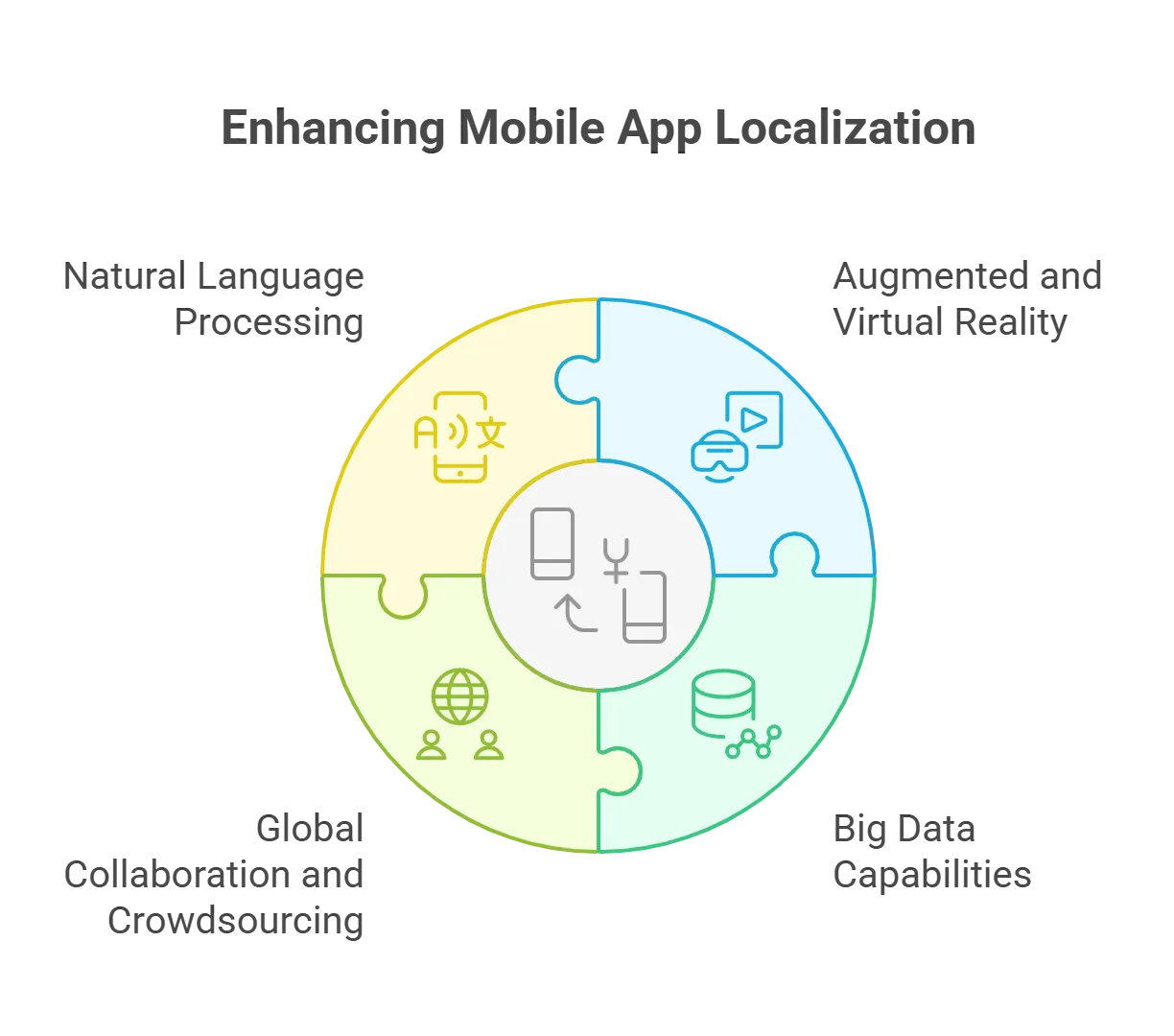
What’s Next in Localization Technology? Trends You Shouldn’t Miss
Summarize with:
There has been a swift acceleration toward digitalization across the globe. As businesses moved operations online, they opened themselves to a global audience. Realizing the untold opportunities this situation presented, companies strived to bridge the gap between diverse cultures and customers worldwide, which led to a surge in demand for localization technology.
This blog will explore the latest trends that are taking localization technology by storm.
Table of Contents:
- What is Localization?
- What is Mobile App Localization?
- Why is it Important?
- The Latest Trends Driving Localization Technology
- The Future of Mobile App Localization
- Summing Up
What is Localization?
Localization is tailoring a specific product, service, or content to align and resonate well with particular markets and their cultures. Localization, however, is not the same as translation, and it is common for individuals to misconstrue the nuanced disparity between these two concepts.
Translation, in essence, facilitates the conversion of texts from one language to another. On the other hand, localization transcends mere translation by meticulously tailoring content to align with the peculiarities of a specific market or region. The amalgamation of these two concepts is the basis of localization technology.
What is Mobile App Localization?
Mobile app localization can be understood as the simple process of customizing a mobile app’s elements to make them relevant for the users. This includes content, design, language, features, etc.
It will not only help you decrease your competition in the market but also substantially improve your conversion rates. Advanced technology in digital landscapes can now allow you to localize your app quickly and efficiently.
However, it is important to remember that app localization technology should not be confused with translation technology. Merely translating the app’s content to the local language won’t be sufficient. You must consider all economic, social, geographical, and cultural elements while doing mobile app localization.
Let us understand this with a hypothetical example of a travel information app called ‘Go Travel,’ which was initially launched in India. Due to the app’s success, the company decided to build a global audience and launched the app in Korea.
Mentioned here are some of the steps ‘Go Travel’ took to localize their app in Korea:
- The app’s layout was kept the same, but the colors were altered to suit Korean aesthetics.
- The payment option was integrated with local payment methods supporting the Korean currency.
- The date and time format was adjusted to match the Korean conventions.
- Users were recommended travel options based on local climatic conditions, festivals, traditional customs, etc.
- The textual content in the app was translated from English & Hindi to Korean.
Why is it Important?
Today’s customers are extremely brand-conscious. Gone are the days when blanket ads played on television were enough to entice the masses to buy into your marketing strategy. Customers today choose products primarily based on a brand’s identity. Factors like being eco-friendly or being inclusive (digitally and culturally) matter greatly.
Apart from this, localization services can also help businesses in several different ways, including the following:
- They help businesses gain a foothold in new markets by making their products or services relevant or avoiding unintentional faux pas.
- You increase your customer pool to those who can only speak or understand the local language.
- You improve customer satisfaction and brand value by respecting the local culture and values.
In short, localization can give you a competitive edge in the global market and help you grow your business across borders.
The Latest Trends Driving Localization Technology
Localization technology is revolutionizing the way businesses reach global audiences. In this section, we will explore the transformative advancements and trends that are driving this revolution.

1. The Proliferation of AI Into Existing Localization Technology.
It has become impossible to talk about emerging trends without mentioning Artificial Intelligence. It became a hot topic after the release of Open AI’s Chat GPT. Today, it is already a USD 196.63 billion industry and is expected to hit a whopping USD 1.81 trillion in just seven short years.
With the emergence of advanced neural machine translation (NMT) technology, AI-based translation services have become more accurate and efficient. With immense computing power behind it, NMT has reached a point where it can comprehend complex documents and local expressions.
That said, AI still has a long way to go to take on this task autonomously and still needs intervention from expert human translators. In the context of translation and localization services, an amalgamation of AI and human expertise will be the way forward, at least for the near future.
2. The Rise of Multimodal Localization
Online learning is the current norm in higher education and corporate training. E-learning creators and corporate training solutions will soon need multimodal localization functionalities from eLearning localization services.
Simply put, multimodal localization is a process of adapting online learning content to different languages and cultures using various media, such as text, audio, video, and graphics. The goal is to make learning more engaging and effective for students or the workforce by helping them understand the content in their local language more clearly while avoiding cultural misunderstandings.
From the perspective of educators, multimodal localization opens up the possibility of reaching a broader and more diverse audience by offering courses in multiple languages and formats.
3. The Rise of Multilingual SEO as a Critical Strategy for Internationalization
The widespread adoption of multilingual SEO strategies could be another emerging trend in localization technology in the coming years. As businesses push to go global, multilingual SEO could be the cost-effective and highly scalable approach to capitalizing on non-English-speaking markets.
Multilingual SEO strategies are multifold:
- Technical SEO involves analyzing the website and implementing targeted optimizations based on location and language.
- The emphasis then changes to off-page SEO, where localization providers concentrate on tasks like translating customer reviews and building multilingual links.
- Finally, on-page SEO is concerned with optimizing website aspects for each target language by translating and localizing website material and adjusting content to cultural preferences.
In short, multilingual SEO will help businesses establish a strong global presence by capitalizing on the ability to connect with a diverse customer base.
4. Improvements in Existing Translation Software
The software used in the translation industry is expected to undergo notable enhancements in the coming years. Implementing speech recognition technologies will greatly facilitate the process of dictating articles and enable a smooth transition in the speech translation niche.
Furthermore, due to the expansion of online video content consumption, there will be a significant demand for video translation services. A key trend that will emerge during this time is inclusive localization. It emphasizes ensuring accessibility for individuals with impairments, for example, by providing audio descriptions and closed captions. Localization professionals can make the material understandable and inclusive for all consumers.
The Future of Mobile App Localization
As mentioned above, most localization tools now utilize artificial intelligence, allowing customers to leverage the full potential of the platform’s capabilities. These localization tools also enable users to incorporate various digitally advanced tools in their apps to communicate with their customers more efficiently.

Statistics reveal that 95% of customer interactions will be AI-enabled by 2025. Consequently, you need to jump on the bandwagon and integrate the latest technologies in your app localization activities. It will prove to be highly beneficial for both you and your customers.
Mentioned here are some potential latest technologies you can utilize:
1. Augmented Reality and Virtual Reality
Mixed reality (virtual reality + augmented reality) is offering exciting new opportunities. Virtual reality’s annual growth is expected to rise 28% until 2028. To enhance user engagement, you can now add 3D models and audio assets to your app.
The immersive environment contextualized in the local know-how will allow customers to build their trust in you. You can also experiment with local interaction and communication conventions to break them and allow your customers to converse with you comfortably.
2. Big Data Capabilities
By fully leveraging big data capabilities, you can take a more data-driven approach to localizing your app. The data allows you to analyze comprehensive user behavior across multiple geographical regions and languages.
Additionally, the analytical capabilities can help you catch your localization errors more robustly. Continual adaptation will allow you to enhance your user experience.
3. Global Collaboration and Crowdsourcing
If you wish to streamline the localization process to be more cost-effective and culturally accurate, you must experiment with global collaboration and crowdsourcing techniques. You will be able to get insights from a vast network of experts worldwide and adapt to the localization process more accurately.
With real-time collaboration options with language experts, developers, translators, etc., you can ensure your business’s objective is not misrepresented in the localization process. Numerous global collaboration platforms are available in the digital market.
Some highly advanced ones come with an in-built quality control and peer review process. This can help you significantly improve the quality of the localization process by resonating accurately with all cultural and linguistic backgrounds.
4. Natural Language Processing
Natural language processing, also called NLP, provides a deeper and more complex understanding of culturally relevant language and translations. Digitally driven NLP algorithms automatically analyze and translate the context of words, phrases, idioms, and sentences.
It ensures the context and translations align with the local dialect and understanding. Additionally, NLP can provide advanced multilingual support, breaking down language barriers and fostering smooth global communication and interaction.
Some other highly beneficial elements of NLP include voice-activated features, translation management, sentiment analysis, regional understanding, and more.
Summing Up
Localization Technology is seeing some exciting developments in 2023. AI, multimodal localization, and the fact that translation software is becoming more adept by the minute are all opening up new windows of opportunities for organizations looking to truly internationalize themselves.
However, if businesses want to stay ahead of the curve, they can capitalize on these trends and hire the best software localization services. It will enable them to reach new clients without linguistic or cultural obstacles.
Hurix Digital is the ideal partner for companies requiring localization or online learning assistance. We have a team of skilled localization specialists who can help you translate and localize your material into any language. We also provide various online learning options to help you train your staff, onboard new personnel, and comply with legislation.
Contact Hurix Digital today to learn more about our localization and online learning solutions.
Summarize with:

Senior Vice President
Julia brings over 20 years of global experience in digital learning and business strategy. She specializes in client success, enterprise learning solutions, and driving growth through innovation, with a focus on AI, VR, and emerging technologies across diverse industry verticals.
 Upcoming Masterclass | Build an Army of Brand Evangelists using Training & Development | November 20th, 8:30 AM PDT | 11:30 AM EDT | 10:00 PM IST
Upcoming Masterclass | Build an Army of Brand Evangelists using Training & Development | November 20th, 8:30 AM PDT | 11:30 AM EDT | 10:00 PM IST





